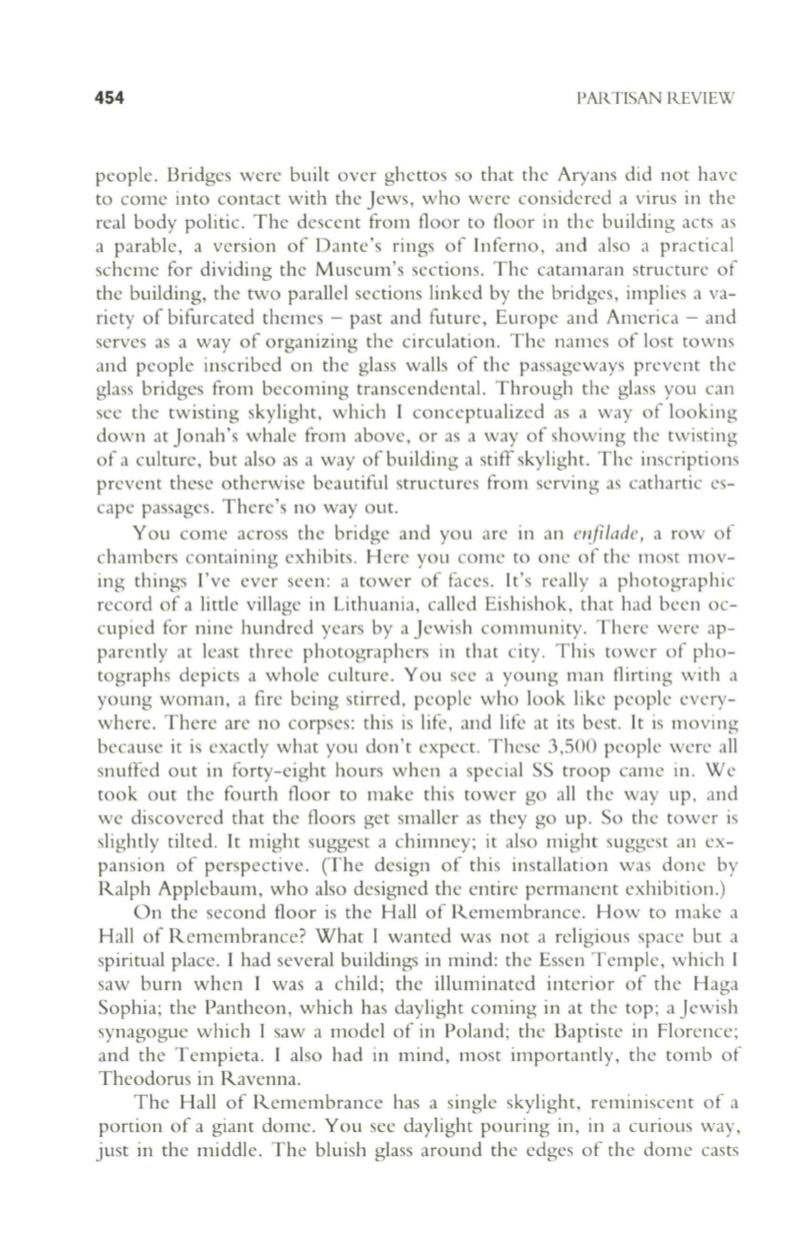
454
PARTISAN REVIEW
people. Bridges were built over ghettos so that the Aryans did not have
to come into contact with the Jews, who were considered a virus in the
real body politic. The descent from floor to floor in the building acts as
a parable, a version of Dante's rings of Inferno, and also a practical
scheme for dividing the Museum's sections. The catamaran structure of
the building, the two parallel sections linked by the bridges, implies a va–
riety of bifurcated themes - past and future, Europe and America - and
serves as a way of organizing the circulation. The names of lost towns
and people inscribed on the glass walls of the passageways prevent the
glass bridges from becoming transcendental. Through the glass you can
see the twisting skylight, which I conceptualized as a way of looking
down at Jonah's whale from above, or as a way of showing the twisting
of a culture, but also as a way of building a stiff skylight. The inscriptions
prevent these otherwise beautiful structures from serving as cathartic es–
cape passages. There's no way out.
You come across the bridge and you are in an
enJi lade,
a row of
chambers containing exhibits. Here you come to one of the most mov–
ing things I've ever seen: a tower of faces. It's really a photographic
record of a little village in Lithuania, called Eishishok, that had been oc–
cupied for nine hundred years by a Jewish community. There were ap–
parently at least three photographers in that city. This tower of pho–
tographs depicts a whole culture. You see a young man flirting with a
young woman, a fire being stirred, people who look like people every–
where. There are no corpses: this is life, and life at its best. It is moving
because it is exactly what you don't expect. These 3,500 people were all
snuffed out in forty-eight hours when a special SS troop came in . We
took out the fourth floor to make this tower go all the way up, and
we discovered that the floors get smaller as they go up. So the tower is
slightly tilted. It might suggest a chimney; it also might suggest an ex–
pansion of perspective. (The design of this installation was done by
Ralph Applebaum, who also designed the entire permanent exhibition.)
On the second floor is the Hall of Remembrance. How to make a
Hall of Remembrance? What [ wanted was not a religious space but a
spiritual place. I had several buildings in mind: the Essen Temple, which I
saw burn when [ was a child; the illuminated interior of the Haga
Sophia; the Pantheon, which has daylight coming in at the top; a Jewish
synagogue which I saw a model of in Poland; the Baptiste in Florence;
and the Tempieta. I also had in mind, most importantly, the tomb of
Theodorus in Ravenna.
The Hall of Remembrance has a single skylight, reminiscent of a
portion of a giant dome. You see daylight pouring in, in a curious way,
just in the middle. The bluish glass around the edges of the dome casts


